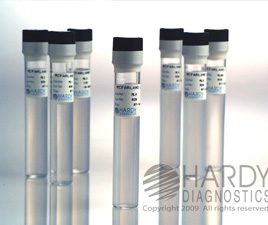INTENDED USE
McFarland Latex Standards are used as turbidity standards for adjusting densities of bacterial suspensions.
SUMMARY
McFarland Standards provide a reference for standardization of bacterial suspensions used for susceptibility testing and other procedures that require a standardized inoculum. Original McFarland Standards were prepared by adding barium chloride to sulfuric acid resulting in a barium sulfate precipitation.(4) CLSI now accepts the use of latex particle suspension turbidity standards for the preparation of standardized bacterial suspensions.(8)
The McFarland Latex Standards are prepared from suspensions of uniform latex particles with similar absorbance values as the original barium sulfate standards. The latex standards are prepared by suspending latex particles in a buffer solution. Sodium azide is added as a preservative. The standards are adjusted to an acceptable absorbance range with a one centimeter light path set at 625nm. Adjusting the bacterial suspension turbidity to a McFarland Standard produces bacterial counts in an expected range. As with the barium sulfate standards, a 0.5 McFarland Latex Standard is comparable to a bacterial suspension of 1.5 X 108 CFU/ml.
The stability of McFarland Latex Standards allows for a significantly longer shelf-life than the original barium sulfate standards due to reduced light sensitivity.
STORAGE AND SHELF LIFE
Storage: Upon receipt store at 2-30ºC. These products are ready for use and no further preparation is necessary. These products should be stored in their original container. Do not freeze or overheat. Do not incubate prior to use. Standards should not be used if there are any signs of deterioration, contamination, color change or if the expiration date has passed.
The expiration dating on the product label applies to the product in its intact packaging when stored as directed.
Refer to the document “Storage” on the Hardy Diagnostics Technical Document website for more information.
PRECAUTIONS
This product may contain components of animal origin. Certified knowledge of the origin and/or sanitary state of the animals does not guarantee the absence of transmissible pathogenic agents. Therefore, it is recommended that these products be treated as potentially infectious, and handle observing the usual universal blood precautions. Do not ingest, inhale, or allow to come into contact with skin.
This product is for in vitro diagnostic use only. It is to be used only by adequately trained and qualified laboratory personnel. Observe approved biohazard precautions and aseptic techniques. All laboratory specimens should be considered infectious and handled according to “standard precautions.” The “Guidelines for Isolation Precautions” is available from the Centers for Disease Control and Prevention at www.cdc.gov/ncidod/dhqp/gl_isolation.html.
For additional information regarding specific precautions for the prevention of the transmission of all infectious agents from laboratory instruments and materials, and for recommendations for the management of exposure to infectious disease, refer to CLSI document M-29: Protection of Laboratory Workers from Occupationally Acquired Infections: Approved Guideline.
Sterilize all biohazard waste before disposal.
Refer to the document “Precautions When Using Media” on the Hardy Diagnostics Technical Document website for more information.
Refer to the document SDS Search instructions on the Hardy Diagnostics website for more information.
PROCEDURE
Specimen Collection: Not applicable since these standards are used for the standardization of inoculum for susceptibility testing. Isolation techniques and tests for purity are necessary. Information on specimen collection may be found in standard reference texts.
Method of Use:
1. Mix the standard to fully suspend the particles. Gently mix the McFarland Latex Standards (ML05-ML8) by inverting – Do not vortex the latex standards.
2. Adjust the turbidity of an actively growing broth culture or bacterial suspension of colonies selected from an 18-24 hour agar plate to obtain a turbidity visually comparable to that of the desired standard. The tubes for the suspension should be the same diameter as the McFarland Latex Standard tube.
3. For visual comparison, use adequate light and read the tubes against a white card with contrasting black lines (Wickerham Card, Cat. no. Z08).(3)
INTERPRETATION OF RESULTS
Equal obliteration or distortion of contrasting black lines on the white background indicates a turbidity match.
LIMITATIONS
Do not use a mechanical mixer (vortex) with latex standards.
Broth media that is dark yellow, orange or brown will not provide the proper contrast with McFarland Latex Standards, possibly resulting in bacterial suspensions of incorrect densities. Trial comparisons should be performed.(5) Use adequate light and read the standard and test broth against a white card with contrasting black lines (Wickerham Card, Cat. no. Z08).(3)
The tubes for the suspension should be the same diameter as the McFarland Latex Standard tube.
Bacterial densities may be too heavy when colonies of Haemophilus influenzae < 24 hours old are used to prepare suspensions.(6) McFarland Standards are recommended when performing visual comparisons or when using a spectrophotometer adjusted to the proper setting.(5,7) Use with instruments which use alternative light sources, such as scattered light, have not been established. Refer to the document "Limitations of Procedures and Warranty" on the Hardy Diagnostics Technical Document website for more information. MATERIALS REQUIRED BUT NOT PROVIDED Standard microbiological supplies and equipment such as loops, broth media, vortex mixer and Wickerham Card (Cat. no. Z08), etc., are not provided. QUALITY CONTROL All lot numbers of McFarland Latex Standards are tested spectrophotometrically and have been found to be acceptable. PHYSICAL APPEARANCE McFarland Latex Standards appear white with a bluish tinge.





